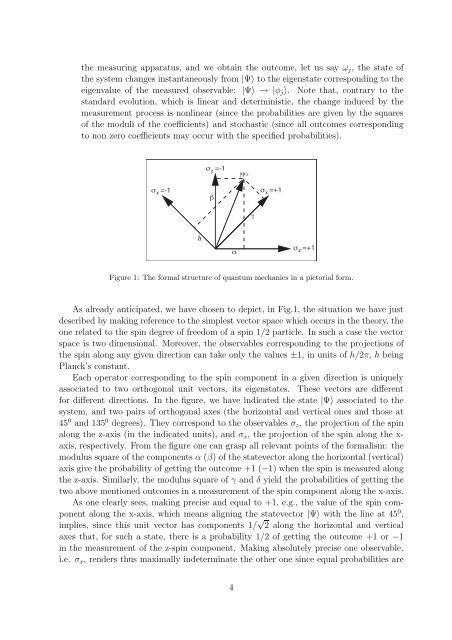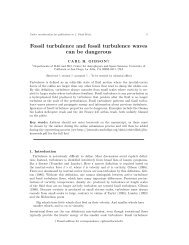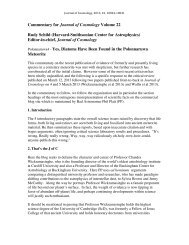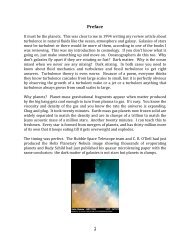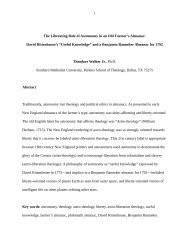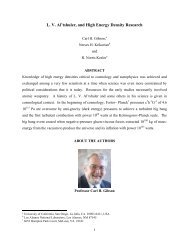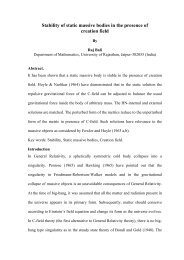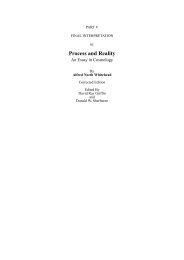The Macro-Objectification Problem and Conscious Perceptions
The Macro-Objectification Problem and Conscious Perceptions
The Macro-Objectification Problem and Conscious Perceptions
You also want an ePaper? Increase the reach of your titles
YUMPU automatically turns print PDFs into web optimized ePapers that Google loves.
the measuring apparatus, <strong>and</strong> we obtain the outcome, let us say ωj, the state of<br />
the system changes instantaneously from |Ψ〉 to the eigenstate corresponding to the<br />
eigenvalue of the measured observable: |Ψ〉 → |φj〉. Note that, contrary to the<br />
st<strong>and</strong>ard evolution, which is linear <strong>and</strong> deterministic, the change induced by the<br />
measurement process is nonlinear (since the probabilities are given by the squares<br />
of the moduli of the coefficients) <strong>and</strong> stochastic (since all outcomes corresponding<br />
to non zero coefficients may occur with the specified probabilities).<br />
σ =-1<br />
x<br />
δ<br />
σ =-1<br />
z<br />
β<br />
α<br />
|Ψ><br />
γ<br />
σ =+1<br />
x<br />
σ =+1<br />
z<br />
Figure 1: <strong>The</strong> formal structure of quantum mechanics in a pictorial form.<br />
As already anticipated, we have chosen to depict, in Fig.1, the situation we have just<br />
described by making reference to the simplest vector space which occurs in the theory, the<br />
one related to the spin degree of freedom of a spin 1/2 particle. In such a case the vector<br />
space is two dimensional. Moreover, the observables corresponding to the projections of<br />
the spin along any given direction can take only the values ±1, in units of h/2π, h being<br />
Planck’s constant.<br />
Each operator corresponding to the spin component in a given direction is uniquely<br />
associated to two orthogonal unit vectors, its eigenstates. <strong>The</strong>se vectors are different<br />
for different directions. In the figure, we have indicated the state |Ψ〉 associated to the<br />
system, <strong>and</strong> two pairs of orthogonal axes (the horizontal <strong>and</strong> vertical ones <strong>and</strong> those at<br />
45 0 <strong>and</strong> 135 0 degrees). <strong>The</strong>y correspond to the observables σz, the projection of the spin<br />
along the z-axis (in the indicated units), <strong>and</strong> σx, the projection of the spin along the xaxis,<br />
respectively. From the figure one can grasp all relevant points of the formalism: the<br />
modulus square of the components α (β) of the statevector along the horizontal (vertical)<br />
axis give the probability of getting the outcome +1 (−1) when the spin is measured along<br />
the z-axis. Similarly, the modulus square of γ <strong>and</strong> δ yield the probabilities of getting the<br />
two above mentioned outcomes in a measurement of the spin component along the x-axis.<br />
As one clearly sees, making precise <strong>and</strong> equal to +1, e.g., the value of the spin component<br />
along the x-axis, which means aligning the statevector |Ψ〉 with the line at 45 0 ,<br />
implies, since this unit vector has components 1/ √ 2 along the horizontal <strong>and</strong> vertical<br />
axes that, for such a state, there is a probability 1/2 of getting the outcome +1 or −1<br />
in the measurement of the z-spin component. Making absolutely precise one observable,<br />
i.e. σx, renders thus maximally indeterminate the other one since equal probabilities are<br />
4


